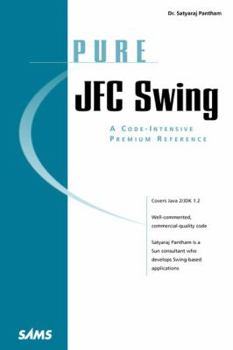Pure Jfc Swing
The most important part of the Java 2 (JDK 1.2) standard is its Swing user interface classes. Pure JFC Swing is a well-organized guide to all the new Swing components, and it includes clear... This description may be from another edition of this product.
Format:Paperback
Language:English
ISBN:0672314231
ISBN13:9780672314230
Release Date:February 1999
Publisher:Sams
Length:806 Pages
Weight:2.65 lbs.
Dimensions:2.0" x 6.1" x 8.9"
Customer Reviews
5 ratings
Nice examples, Nice index
Published by Thriftbooks.com User , 23 years ago
I have 10 years C++ and OOD, but am new to Java. In the last 3 weeks, I have gotten the language down pretty well, but am still climbing the learning curve on Swing. I found the index confusing at first, but now I realize that it is quite powerful. It took me about 5 minutes of dedicated effort to figure the index and appendices out, but now I find it very useful (the confusion derives from the index's redundancy, but once you figure this out the redundancy can be used to advantage). Appendix A (JFC Swing Quick Reference) is really poorly laid out. It is 261 pages with nothing but "Appendix A" listed at the top of each page. I believe it is laid out by package. As such, the least they could do is put the package name at the top of each page or dictionary-style black markings along the edges of pages as in several O'Reilly texts. I recommend not starting with Appendix A; look to the index and let it tell you what page to jump to in Appendix A. I have 8 Java books that I purchased in the last 3 weeks; this one does something very helpful. The text descriptions of code samples are described with reference to specific code blocks, i.e., "snippet 1 does...", "snippet 2 does...". This is VERY helpful because if you scan a code sample, you are likely familiar with 90% of the code sample. With this text's format you can rapidly skip past the text descriptions for the code you already understand. I have found this EXTREMELY helpful (I waste a lot of time in a lot of books reading the same information over and over again). This is the first book outside of the O'Reilly series that I have found useful in my effort to learn Java. In sum, the value of this book (for me) derives from its presentation of the big picture on Swing. I don't need a book that goes into endless detail about specific methods and classes (I can get this from numerous reference sources...and I can learn this over time while developing). The value of this book comes from its ability to give you the big picture and train you on Swing-based design patterns and methodologies. I already know A LOT about GUI development, OOD, using foundation classes, etc...what I needed to learn was the "Swing way" of doing things. So, if you share my background, this book will be very useful.
Excellent for experienced Java Developers
Published by Thriftbooks.com User , 24 years ago
When I learned Java a few years ago I fiddled around with the AWT and the event model. When Swing was released I was afraid that, due to its size and complexity, it would be difficult to learn. After an hour of reading Pure JFC Swing I had what I needed to begin creating GUIs with swing components. The book is not for beginners but if you know Java and the AWT this book has exactly the information you need (no filler) to grasp swing quickly.
Good reference for the advanced user
Published by Thriftbooks.com User , 24 years ago
This would be a difficult book for beginners, but does supply a lot of advanced information about using the Swing package. The general stuff at the beginning would be better served if replaced by a reference to the online tutorial at java.sun.com site. I recomend this text to anyone who needs or wants to use Swing.
Great book for a great price!
Published by Thriftbooks.com User , 25 years ago
I have been really benefited from this book. This book provides a no-nonsense tutorial without wasting time. Packed with a number of practical examples on tables, trees, lists and comboboxes, in addition to the other basic examples. Serves as a good desktop reference with a huge index (but still incomplete). Above all it is gentle on your pocket; only few bucks.
The best Swing example book yet!
Published by Thriftbooks.com User , 25 years ago
I've read several books on Swing, in my quest to master its intricacies. Books like 'Java Swing' by O'Reilly are good as references, but contain limited examples (and their tree section is terrible). That's why you need a book like 'Pure JFC Swing' - to give you examples and code snippets for real world applications. You can learn a lot by looking at example code - or just take it an put it in your own applications for impressive results.My one complaint, and it is small, is that there is no CD. This means you have to download the code from the publisher's site (it is there - be persistent). Despite this, once you have the code, you can try all the examples form the book or cut and paste it into your own Swing apps. Its packed full of great examples, covering most (if not all) of the Swing components. They also happen to be far superior to those offered by other titles.




